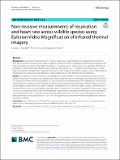| dc.contributor.author | Rzucidlo, Caroline L. | |
| dc.contributor.author | Curry, Erin | |
| dc.contributor.author | Shero, Michelle R. | |
| dc.date.accessioned | 2023-04-03T12:11:45Z | |
| dc.date.available | 2023-04-03T12:11:45Z | |
| dc.date.issued | 2023-03-29 | |
| dc.identifier.uri | https://hdl.handle.net/1721.1/150333 | |
| dc.description.abstract | Abstract
Background
An animal’s metabolic rate, or energetic expenditure, both impacts and is impacted by interactions with its environment. However, techniques for obtaining measurements of metabolic rate are invasive, logistically difficult, and costly. Red–green–blue (RGB) imaging tools have been used in humans and select domestic mammals to accurately measure heart and respiration rate, as proxies of metabolic rate. The purpose of this study was to investigate if infrared thermography (IRT) coupled with Eulerian video magnification (EVM) would extend the applicability of imaging tools towards measuring vital rates in exotic wildlife species with different physical attributes.
Results
We collected IRT and RGB video of 52 total species (39 mammalian, 7 avian, 6 reptilian) from 36 taxonomic families at zoological institutions and used EVM to amplify subtle changes in temperature associated with blood flow for respiration and heart rate measurements. IRT-derived respiration and heart rates were compared to ‘true’ measurements determined simultaneously by expansion of the ribcage/nostrils and stethoscope readings, respectively. Sufficient temporal signals were extracted for measures of respiration rate in 36 species (85% success in mammals; 50% success in birds; 100% success in reptiles) and heart rate in 24 species (67% success in mammals; 33% success in birds; 0% success in reptiles) using IRT-EVM. Infrared-derived measurements were obtained with high accuracy (respiration rate, mean absolute error: 1.9 breaths per minute, average percent error: 4.4%; heart rate, mean absolute error: 2.6 beats per minute, average percent error: 1.3%). Thick integument and animal movement most significantly hindered successful validation.
Conclusion
The combination of IRT with EVM analysis provides a non-invasive method to assess individual animal health in zoos, with great potential to monitor wildlife metabolic indices in situ. | en_US |
| dc.publisher | BioMed Central | en_US |
| dc.relation.isversionof | https://doi.org/10.1186/s12915-023-01555-9 | en_US |
| dc.rights | Creative Commons Attribution | en_US |
| dc.rights.uri | https://creativecommons.org/licenses/by/4.0/ | en_US |
| dc.source | BioMed Central | en_US |
| dc.title | Non-invasive measurements of respiration and heart rate across wildlife species using Eulerian Video Magnification of infrared thermal imagery | en_US |
| dc.type | Article | en_US |
| dc.identifier.citation | BMC Biology. 2023 Mar 29;21(1):61 | en_US |
| dc.contributor.department | Woods Hole Oceanographic Institution | |
| dc.identifier.mitlicense | PUBLISHER_CC | |
| dc.eprint.version | Final published version | en_US |
| dc.type.uri | http://purl.org/eprint/type/JournalArticle | en_US |
| eprint.status | http://purl.org/eprint/status/PeerReviewed | en_US |
| dc.date.updated | 2023-04-03T04:59:06Z | |
| dc.language.rfc3066 | en | |
| dc.rights.holder | The Author(s) | |
| dspace.date.submission | 2023-04-03T04:59:06Z | |
| mit.license | PUBLISHER_CC | |
| mit.metadata.status | Authority Work and Publication Information Needed | en_US |
